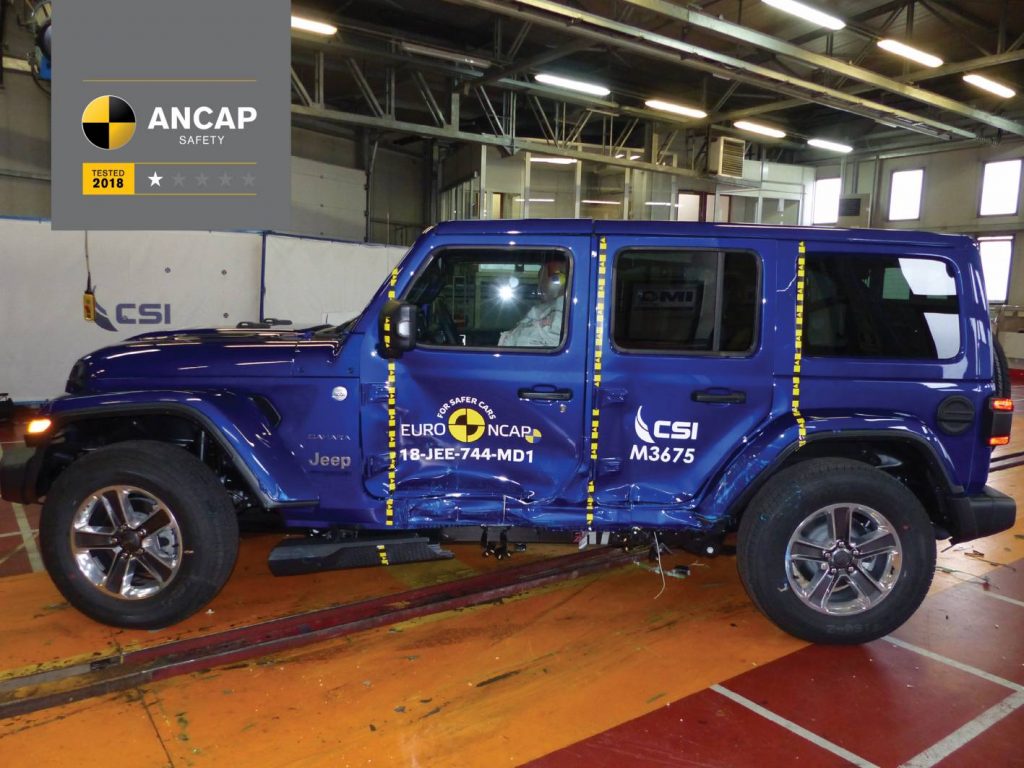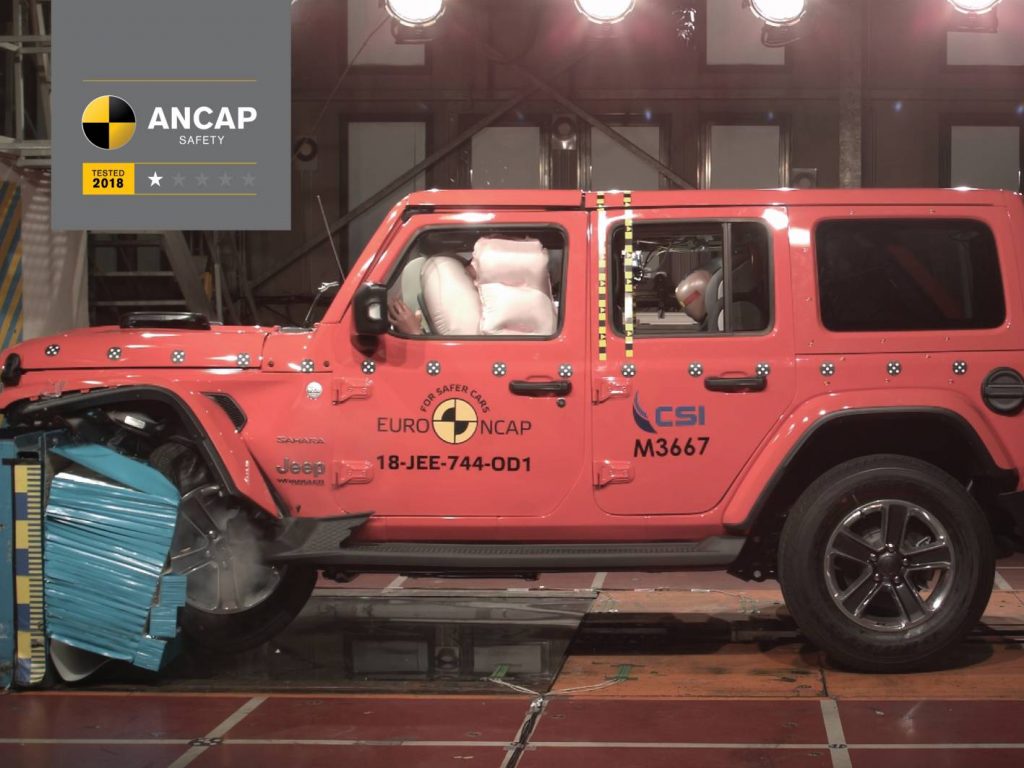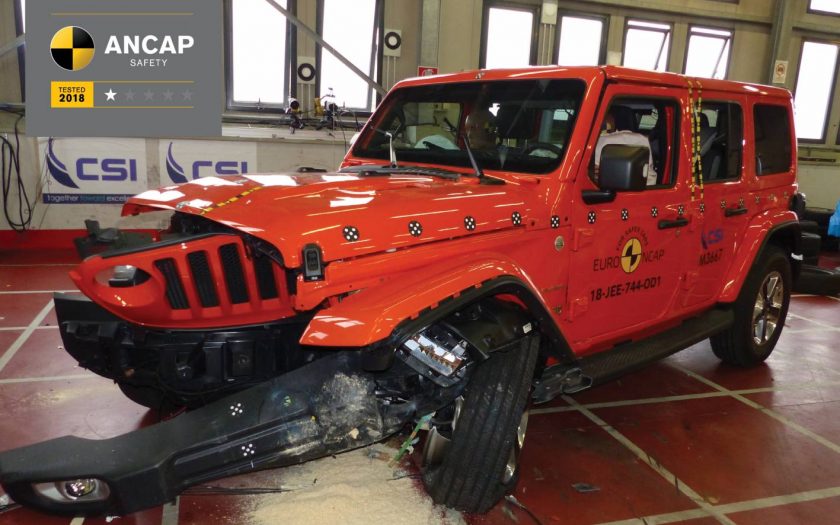IN WHAT IS SURE TO BE bad news for the multitudes of Jeep fans, the new Wrangler has scored a truly abysmal one ANCAP star in the latest ranking released by ANCAP today.
This is especially concerning since Wranglers are highly popular with younger drivers and, despite their remarkable off-road capabilities, often bought as fashion accessories.
Commenting in defence of Fiat Chrysler Australia, director of corporate communications Tracie Stoltenburg said, “… every other member of the Jeep family wears a five-star safety rating with pride, whether tested by ANCAP in Australia or Euro NCAP.”
She went on to make the not unreasonable point that the Jeep Wrangler is a specialist off-road performance vehicle that “has more than 70 advanced standard and available safety equipment (features). This includes front and side airbags, blind-spot monitoring, rear cross-path detection, parking sensors, a rear-view camera and autonomous emergency braking, all of which are paired with the use of high-strength steel in the Wrangler’s construction designed to protect the cabin in the case of an accident.” She added, “The Wrangler also meets federal safety requirements in Australia and is compliant with Australian Design Rules (ADR), the national government standards for vehicle safety, anti-theft and emissions in Australia.”
The issue is not as straightforward as it initially appears. It’s that small problem of “standard and available safety equipment”. The base model Sport S Wrangler misses out on autonomous emergency braking which would have weighed against a higher ANCAP score for the model range (it will become standard on the base model next year) and other safety equipment that would have led to a higher rating is optional, not standard. But there is more than a little validity that testing methods do not favour specialist off-road vehicles (for example, the body-on-chassis construction that makes it possible to remove the roof and doors of the Wrangler compromises frontal and side impact crash testing results, and beam axles, high ride-height and off-road tyres essential for serious off-roading put the Wrangler at a disadvantage in ANCAP’s on-road-skewed testing).
But, by the same token, if you are heading out of town to go off-roading, you’ll have to drive along public roads and highways to get there.
In testing the Wrangler managed just 50 percent for Adult Occupant Protection, 49 percent for Vulnerable Road User Protection and 32 percent for Safety Assist.

Commenting on the poor results, ANCAP chief executive James Goodwin said, “The safety performance of the Wrangler is limited, falling well shy of the expected standard in three of the four key areas of assessment. Chest protection was a concern for the driver and rear passenger in each of the frontal crash tests; a number of penalties were applied for structural deformation and potential leg injury hazards; and base variants lack autonomous emergency braking altogether.”
The Wrangler scored 3.89 out of 8 for the frontal offset crash at 64km/h (“did not retain its structural integrity”), and 5.72 out of 8 for the full width frontal test at 50km/h (“chest protection of the driver was ‘marginal’; protection for the rear passenger neck was ‘weak’ and chest protection was ‘poor’ based on dummy readings and high seat belt loads”). The news was better for the side impact test (eight points out of eight) and whiplash protection scored 1.67 (out of 2).

Child occupant protection showed ‘good’ protection for the 6-year dummy in all critical body regions, but protection of the neck of the 10-year dummy was ‘weak’ and protection of the chest ‘adequate’. In the side impact test, head protection for the ten-year dummy was ‘marginal’, while other areas for both 10-year and 6-year dummies was ‘good’. Most child restraints offered in Australia could be accommodated in the rear, but tensioning the outboard ISOfix connectors in the two-door was “difficult to achieve” (four-door variants were not assessed).
The news is no better for pedestrians with the Wrangler criticised for ‘poor’ or ‘adequate’ protection to the head of a struck pedestrian over most of its surface. Protection of the pelvis was ‘good’, but leg protection was mixed with areas of ‘good’ and ‘poor’ performance.
The four-door variant with a diesel engine was tested and according to ANCAP, the safety performance of two-door and petrol variants is not expected to be significantly different.
ANCAP noted that dual frontal and combination side airbags which protect both the chest and head of front seat occupants are standard. However, head protecting side airbags are not offered for rear seating positions. Nor is autonomous emergency braking standard, although it is available on some variants, and a lane support system is not available,
If you, or any of your family or loved ones are considering buying a Jeep Wrangler, we’d strongly advise caution. And careful consideration of the optional but highly desirable safety equipment on offer for the Wrangler.
